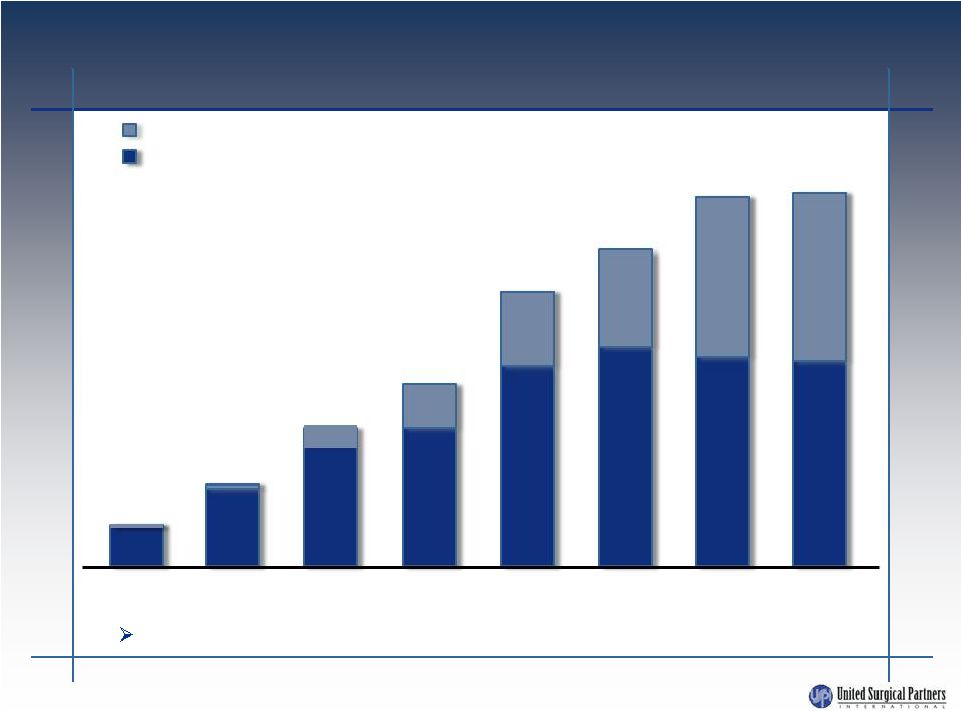Attached files
| file | filename |
|---|---|
| 8-K - FORM 8-K - UNITED SURGICAL PARTNERS INTERNATIONAL INC | d263659d8k.htm |
 USPI
November 2011
Exhibit 99.1 |
 2
SAFE HARBOR STATEMENT
This presentation contains forward-looking statements,
including those regarding United Surgical Partners
International, Inc. and the services it provides. Investors
are cautioned not to place an undue reliance on these
forward-looking statements, which will speak only as of
the date of this presentation. United Surgical Partners
International, Inc. undertakes no obligation to publicly
revise these forward-looking statements. |
 3
NON-GAAP MEASUREMENT
We
have
used
the
non-GAAP
financial
measurement
term
“EBITDA.”
EBITDA
is calculated as operating income plus net gain (loss) on deconsolidations,
disposals, impairments and depreciation and amortization. USPI uses EBITDA and
EBITDA less noncontrolling interests as analytical indicators for purposes of
allocating resources and assessing performance. EBITDA is commonly used as an
analytical indicator within the health care industry and also serves as a measure of
leverage
capacity
and
debt
service
ability.
EBITDA
should
not
be
considered
as
a
measure of financial performance under generally accepted accounting principles,
and the items excluded from EBITDA could be significant components in
understanding and assessing financial performance.
Because EBITDA is not a measurement determined in accordance with
generally
accepted
accounting
principles
and
is
thus
susceptible
to
varying
calculation methods, EBITDA as presented by USPI may not be comparable to
similarly titled measures of other companies. |
 4
COMPANY OVERVIEW
Leading operator of short-stay multi-specialty surgical facilities in the
United States and U.K.
Strategic partnerships with local physicians and prominent not-for-profit
health systems
Strong focus on patient safety, physician efficiency and cost
management
$2.1 billion of revenues under management for 204 facilities
Attractive business model with strong cash flow and modest exposure
to government reimbursement
Industry positioned as low cost, high quality solution for reform
initiatives |
 5
U.S. INDUSTRY OVERVIEW
ASCs have been widely successful and are a significant
presence in the U.S. healthcare delivery system
Advantages in patient safety and physician efficiency are
meaningful
Significant savings to patients, government and commercial
payors
Typically a savings to commercial insurers
Medicare savings >40%
Medicare beneficiary savings >50%
Industry largely unconsolidated
Top ten companies own less than 20%
Growth of new facilities has slowed in recent years |
 6
BENEFITS OF ASCs
All
Constituents
Benefit
PATIENTS
Allows higher patient
satisfaction as a result of more
comfortable setting,
scheduling flexibility and
consistent staffing
HOSPITAL PARTNERS
Allows hospital systems to
expand their capacity and
geographic reach with lower
capital use than traditional
acute care facilities
HIGH QUALITY CARE
92% patient satisfaction
Superior patient outcomes
Comprehensive regulatory
standards
PAYORS
In general, ASC represent a
discount
of
20
–
30%
compared with HOPD
reimbursement
PHYSICIANS
Freestanding environment
more conducive to meeting
high volume physicians’
requirements
Significant administrative,
clinical and economic benefits
to physicians
6 |
 7
GROWING MARKET
Source: Verispan report and Wall Street research
Freestanding Facility Outpatient Surgeries
Hospital Outpatient
1981
1985
1990
1995
2002
2005
2007
Continued
shift
of
outpatient
surgery
to
freestanding
outpatient
facilities
2009
94%
10%
17%
25%
29%
32%
83%
75%
71%
68%
6%
90%
43%
57%
48%
52% |
 8
KEY MARKETS
USPI operates 199 facilities in the United States and five in
the United Kingdom
Denver
6 facilities
Centura Health
Partnership
Oklahoma City
2 facilities
INTEGRIS Health
Partnership
St. Louis
18 facilities
New Jersey
10 facilities
Meridian Health
Partnership
Nashville
21 facilities
St. Thomas Partnership
Atlanta
6 facilities
Houston
19 facilities
Memorial
Hermann
Partnership
Austin
4 facilities
Seton Partnership
San Antonio/Corpus Christi
3 facilities
CHRISTUS Health Partnership
Dallas/Ft. Worth
32 facilities
Baylor Health Care
System Partnership
Phoenix/Las Vegas
11 facilities
Catholic Healthcare
West Partnership
Los Angeles
6 facilities
Catholic Healthcare
West Providence
Partnership
Kansas City
6 facilities
North Kansas City
Hospital Ascension
Partnership
Chicago
5 facilities
NorthShore University
HealthSystem, Adventist
Partnership
Major Market
Facilities |
 9
UNITED KINGDOM
USPI entered the U.K. market in 2000 and currently operates three private
hospitals, a cancer center in greater London and an outpatient clinic in
Edinburgh, Scotland
Approximately 30% of
the population in the
Greater London market
accesses the private
healthcare market
Strategically located
facilities
Physician-driven
healthcare
Inherent limitations of
National Health System
Strong management
team
London Area Map
Parkside Hospital &
Parkside Oncology
(Wimbledon)
Highgate
Hospital
Holly House Hospital
(Buckhurst Hill)
Facilities |
 10
HEALTHCARE SYSTEM PARTNERS
Benefits to Healthcare Systems
Leverage USPI’s operational
expertise and singular focus
Provides a strategy to promote
physician alignment
Provides defensive mechanism to
maintain short-stay surgical
business
Provides capital and spreads risk
through USPI and physicians’
investment
Provides an opportunity to expand
in new markets at lower capital
outlay than a hospital
Benefits to USPI
Provides long-term strategic
stability in the marketplace
Provides brand, image,
reputation and credibility
Accelerates growth
Enhances relationships with
managed care payors
137 facilities are in a partnership with a healthcare system |
 11
HEALTHCARE SYSTEM PARTNERS
USPI’s
strategy
of
partnering
with
not-for-profit
healthcare
systems
aligns
the
Company’s
facilities
with
strong
networks
of
physicians
and
hospitals
that
are
prominent
in
their
communities
and
known
for
providing
high
quality
care
BON SECOURS HEALTH SYSTEM, INC. |
 12
FAVORABLE REVENUE AND PAYOR MIX
High margin, elective procedures
55% of revenue mix from orthopedic
and pain management
Diversification of specialties insulates
USPI from negative utilization and
specialty pricing changes
Over 80% private insurance
Insurance companies favor low cost
providers
Modest exposure to government
reimbursement fluctuations
Government payor mix worldwide
Reliable payors and operating discipline
yields bad debt expense of less than 2%
of revenues and receivable days
outstanding is under 40 days
Low risk cash flows from high margin
specialties and reliable payors:
Orthopedic
Gynecology
ENT
Gastrointestinal
Plastic
Ophthalmology
Medical/Other
Pain Mgmt.
11%
11%
44%
44%
3%
3%
6%
6%
8%
8%
8%
8%
8%
8%
3%
3%
9%
9%
2010 U.S. Revenue Mix
Private
Insurance
Self-pay
16%
16%
82%
82%
2%
2%
2010 U.S. Payor Mix
Government
General |
 13
DEVELOPMENT STRATEGY
Poised to react to current economic conditions and legislative
changes
Acquisition of troubled facilities
Selective acquisition of strong facilities
Selective de novo development
Selective acquisition of multi-facility companies
Work with existing partners (physicians and hospitals) to grow
market share
Selectively enter new markets with existing or new partners
Attractive demographics and/or payor characteristics
Prominent health system that embraces physician alignment
strategy
Prominent physicians who are influential in the market |
 14
FINANCIAL PROFILE
(in millions)
GAAP Revenue
$ 620.9
$ 615.1
$ 593.5
$576.7
$601.8
Operating Income
$ 162.4
$ 198.1
$ 198.3
$ 210.5
$231.1
Add:
Losses on deconsolidations,
disposals and impairments
(0.4)
1.8
29.2
6.4
2.1
Add:
Depreciation & amortization
35.1
32.3
31.2
29.8
29.7
Less:
Noncontrolling interests
(63.7)
(55.1)
(63.7)
(60.6)
(67.1)
Add:
LBO costs
25.4
-
-
-
-
Add:
Non-recurring expenses
(detailed in Form 10-K and 10-Q)
-
-
(1.0)
14.0
16.6
Adjusted EBITDA less noncontrolling
interests
$ 158.8
$ 177.1
$ 194.0
$ 200.1
$212.4
Growth
11.5%
9.5%
3.1%
4.0%
2
Other Data:
GAAP revenue
(0.9%)
(3.5%)
(2.8%)
5.7%
2
Systemwide revenue growth
14.1%
9.4%
7.3%
12.0%
2
U.S. same-facility revenue growth
10.7%
7.5%
5.4%
5.8%
2
1
TTM 9/30/11
2
Q3 2011 versus Q3 2010
2007
2008
2009
2010
2011
1 |
 15
SYSTEMWIDE FINANCIALS
2007 2008
2009 2010
2011 1
Equity method facilities
21.8%
21.2%
21.5%
21.7%
22.5%
Consolidated facilities
46.5%
48.8%
48.1%
46.7%
44.9%
Weighted average
32.6%
30.2%
29.4%
28.2%
28.4%
1
As of 9/30/11
USPI Ownership
Ownership is stable in each category of facilities; we continue to add a
greater number of equity centers versus consolidated facilities |
 16
CAPITALIZATION
(in millions)
2007
2008
2009
2010
2011
3
Balance sheet data:
Cash
$ 76.8
$ 49.4
$ 34.9
1
$60.3
$55.9
Debt
1,098.1
1,097.9
1,069.8
1,065.7
1,042.0
Net debt
$1,021.3
$1,048.5
$1,036.6
$1,009.5
$986.1
Adjusted EBITDA less
noncontrolling interests
2
$ 158.8
$ 177.1
$ 194.0
$ 200.1
$212.4
4
Debt/EBITDA less
noncontrolling interests
6.43x
5.92x
5.34x
5.04x
4.64x
1
On December 1, 2009, the Company paid an $89 million dividend
2
Adjusted to reflect discontinued operations recorded in 2010
3
As of 9/30/11
4
TTM 9/30/11 |
 17
DEBT MATURITIES
Total debt $1.0 billion as of September 30, 2011
2%
53%
1%
44%
$559.1M
$460.1M
Next 12 Months
Months 13-36
Months 37-60
Beyond 5 years |
 18
SUMMARY
USPI is well positioned: low cost, high quality, high customer
satisfaction provider
Partner with key local not-for-profit hospital systems
Strong partnering capabilities will continue to provide opportunities
for growth, even in difficult times
Focused on key strategic markets with significant market share
Stable revenue growth
Strong equity sponsor in WCAS
Capitalized for growth and flexibility |
